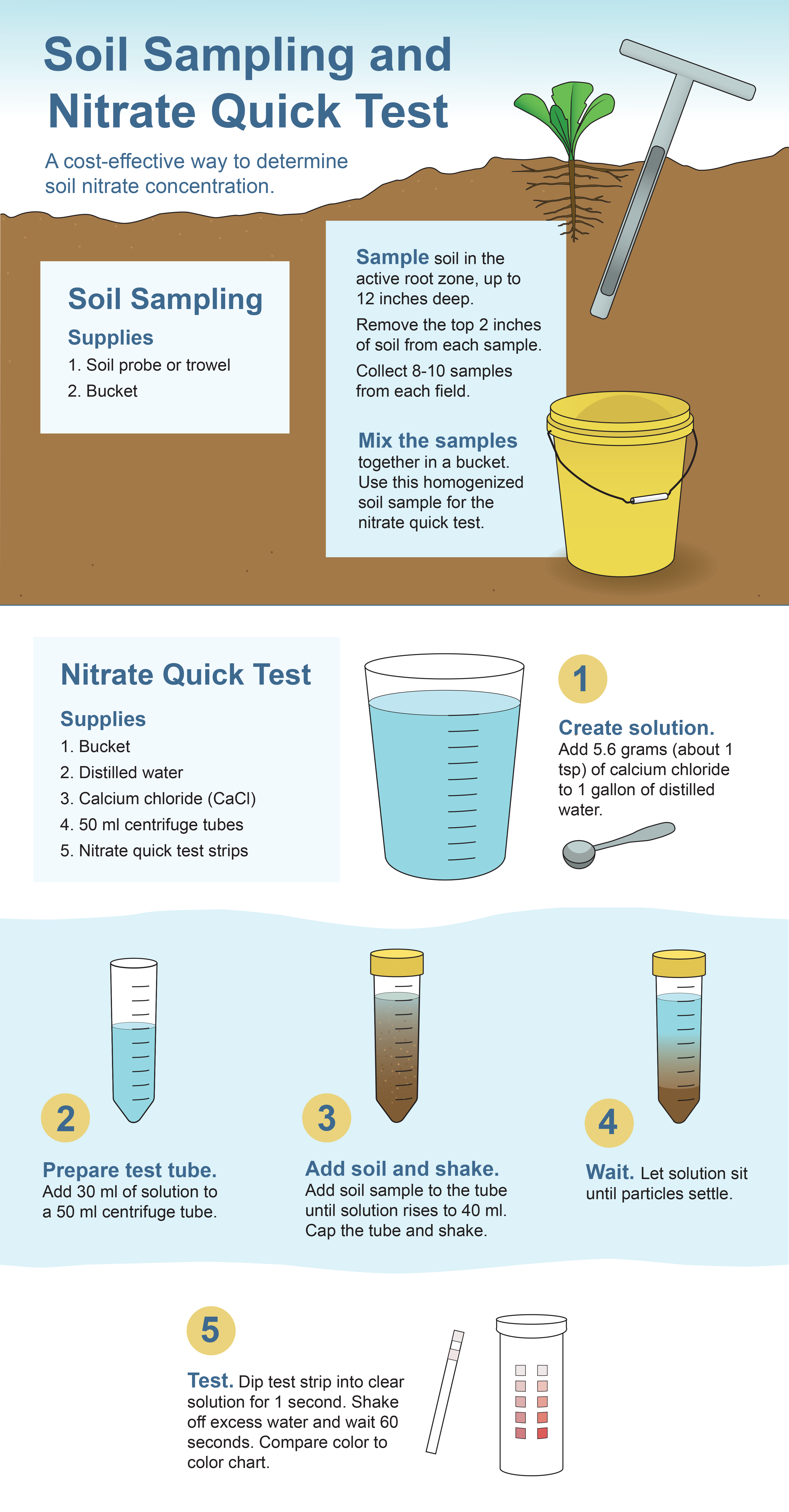The nitrate quick test (NQT) is a cost-effective tool that can be used in nutrient management planning to determine the residual soil nitrate concentration. The results from the test can be used to improve fertilizer management and assist growers in accurately meeting crop needs. Here is an outline of the steps for preparing soil samples, conducting the test and calculating the results.
Supplies
- Soil probe or trowel
- Buckets
- Distilled water
- Calcium chloride (CaCl2)
- 50 milliliter (ml) centrifuge tubes
- Nitrate quick test strips
Soil Sampling
Soil samples for the NQT should be taken near planting or just before a sidedress fertilizer application is made. Sampling depth is dependent on the crop’s active root zone. For vegetable crops, it is most often in the top 2 feet of the soil profile. Try to sample close to the root zone so that the sample is representative of what is available for the plants.
For each sample, remove the top 2 inches of soil, which is above the root zone.
Soil nitrate levels are often variable across a field. To account for nonuniform soil, move in a zig-zag pattern through the field and collect 8 to 10 samples.
Mix the samples thoroughly in a bucket. Use this homogenized soil sample for the NQT.
For more explanation about how to take soil samples, see “Sampling for Soil Nitrate Determination” from the California Fertilization Guidelines (https://apps1.cdfa.ca.gov/FertilizerResearch/docs/Soil_Sampling_Nitrate.pdf)
Nitrate Quick Test
- Create solution. Add 5.6 grams (about 1.0 teaspoon) of calcium chloride to 1.0 gallon of distilled water.
- Prepare test tube. Add 30 ml of the solution to a 50 ml test tube.
- Add soil and shake. Add soil sample to the tube until the solution rises to 40 ml. Cap tube and shake vigorously.
- Wait. Let the solution settle. Time will vary depending on the content of the soil, with clay soils settling slower.
- Test. Dip test strip into clear solution for 1 second. Shake off excess water and wait 60 seconds. Compare to color chart.

Interpreting Results of the Soil Nitrate Quick Test
How much nitrogen (N) is available to your crop?
The nitrate test strip color chart may be calibrated in different units, either parts per million (ppm) nitrate (NO3) or ppm nitrate-nitrogen (NO3-N). Note that milligrams per liter (mg/l) is the same as parts per million (ppm), 1:1.
If the color chart is calibrated in ppm NO3, results should be converted to ppm NO3-N in dry soil, by using a correction factor based on soil texture and moisture.
Test strip reading (ppm NO3) ÷ correction factor = ppm NO3-N in dry soil
| Soil Texture | Moist Soil | Dry Soil |
|---|---|---|
| Sand | 2.3 | 2.6 |
| Loam | 2 | 2.4 |
| Clay | 1.7 | 2.2 |
Example
You have a test strip reading of 30 ppm NO3. The soil is a moist sandy loam (Average 2.3 and 2 to get 2.15). Your NO3-N in dry soil would be:
30 ppm NO3 ÷ 2.15 = 13.9 ppm NO3-N
Meaning of the result
Low levels (10 ppm or less)
Soils with less than 10 ppm NO3-N have a low supply of N. A fertilizer application is usually justified, especially for fast-growing crops. However, late in the season, low soil NO3-N values may indicate efficient crop uptake or movement of nitrate below the sampled layer of soil.
Intermediate levels
Intermediate concentrations may indicate the need for a reduced fertilizer application rate.
Sufficient levels (20 ppm or more)
Soils with NO3-N levels above 20 ppm show that there may be enough nitrogen to meet immediate crop needs, and additional N fertilizer application should be postponed until retesting indicates that residual NO3-N has declined.
The ppm NO3-N in dry soil may then be converted to determine how many pounds of nitrogen are available to your crop per acre by using a conversion factor.
If your soil samples were taken at 12 inches, multiply the number by 4. If you take soil samples to a depth of 6 inches instead of 12 inches, multiply your reading by 2.
Example
Your strip reads 13.9 ppm NO3-N and your samples were taken at a depth of 12 inches.
13.9 x 4 = 55.6 lbs nitrogen/acre available to your crop
Nitrate is mobile, especially in light-textured soils. Heavy rains and irrigation can reduce the amount of available nitrogen in the soil. By becoming familiar with the NQT and interpreting your results, you can confidently make efficient changes to your fertilization plan.
References
- See the NQT printable handout at www.cdfa.ca.gov/is/ffldrs/frep/Resources.html
- Salinas Valley Agriculture Blog, which includes recommendations for NQT supplies. https://ucanr.edu/blogs/blogcore/postdetail.cfm?postnum=4406
- Grower Shipper Association
https://www.growershipper.com/userfiles/file/Nitrate-Quick-Test-SOP-FINAL-ENGLISH.pdf


